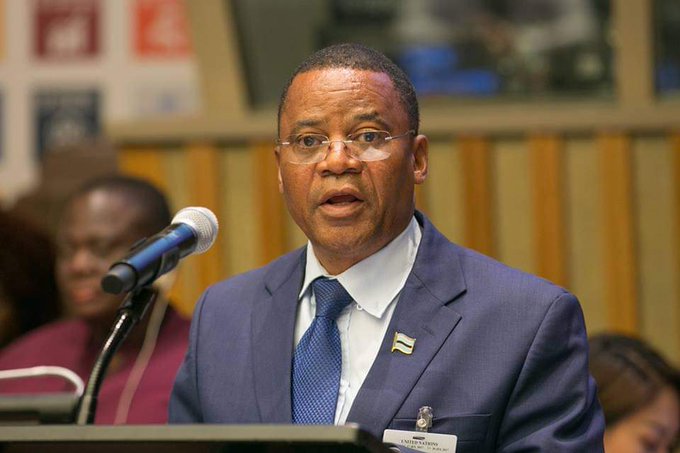|
Getting your Trinity Audio player ready…
|
By Baboloki Semele
Botswana’s vice president Slumber Tsogwane commended the ‘successful’ relationship between African agriculture and the Botswana University of Agriculture and Natural Resources (BUAN) for continuing to bear fruits – and hopefully rice!
Speaking at an event marking the rice harvesting ceremony, held at the university’s Sebele Farms where the project is being carried out, Tsogwne noted that the project started back in 2020 after the Memorandum of Agreement (MOA) which was signed by BUAN and African Agriculture (AA) to work together in finding out whether rice can be grown in the country.
Tsogwane noted that initially, the ambition was to get as much information as possible about raising rice as a crop, and how it responds to diseases, pests, and water. The research was based on the dry land variety which has the potential to produce a tonne to 10 tonnes per hectare.
During the harvesting ceremony, Tsogwne noted that this research on rice, which was successfully conducted, is vital and deserves to be applauded as it is a remarkable milestone in the agricultural sector. He noted that the government of Botswana is committed to the development of farming – smart agriculture being at the forefront and this rice initiative suggests that Batswana is complying with what the country needs to tackle the issue of food security.
But what is the state of food security in Botswana? For a wealthier African country, the prominence of hunger in Botswana may be surprising. Botswana is considered a high-middle-income country with several strong industries, particularly mining diamonds. The exports of diamond mining produce roughly 70% of the country’s GDP.
Despite being wealthy in diamonds, however, the country is poor in food. Compared to such behemoths as the diamond industry, agriculture makes up a minuscule 3% of the economy. From 2016 to 2018, 70% of Botswana’s population faced moderate to severe food insecurity and 26% were malnourished, most of these cases occurring in poor, urban communities.
The country has a large wealth gap between its wealthy and poor citizens, and it is the poor that shoulder the burden of food insecurity and malnourishment. In a study conducted in July-September 2019, in Botswana, 50% of the population was affected by moderate to severe food insecurity in 2018/2019, while 22.2 % of the population was affected by severe food insecurity only.
This translates to 27% of the population being food secure and having adequate access to food in quality and quantity. At the sub-national level, the result shows that among cities or towns, urban villages, and rural areas, the proportion of the population experiencing moderate to severe food insecurity was 31.70%, 46%, 60%, and 65.50 % respectively, while those experiencing severe food insecurity was only 11.90%, 17.50% and 33.10% for the same areas.
Inconsistent Food Production
One of the root causes of food insecurity is poor and inconsistent food production. Botswana’s farmers are hampered by a tempestuous climate that threatens frequent droughts. The Kalahari Desert extends into the country and the arid climate causes large temperature fluctuations that make growing crops extremely difficult.
There are few crops that can grow in even the most favourable conditions in Botswana. The four main crops that can be raised are maize, millet, cowpeas, and sorghum. Even though these crops can survive, however, only 0.65% of Botswana’s land is suitable for farming, and on this fraction of farmland, droughts are still frequent.
In 2018, drought eliminated 75% of the nation’s crops. Due to these unfavorable conditions, most agrarian practices revolve around herding cattle. 85% of agricultural output in Botswana comes from animal products. Only recently, because of several droughts and shrinking herds has the number of people living in Botswana surpassed the number of cows, which are essential for many rural Batswanas.
A Reliance on Imports
Some Batswanas eat beef from their own cattle, but they still must look elsewhere for the remainder of their diet. Because they cannot produce much on their own, much of Botswana’s food is imported from surrounding countries, mainly South Africa. In 2018, Botswana brought in $380 million USD worth of food from South Africa to feed its people. While it is beneficial that Botswana’s next-door neighbor can supply them with a majority of their food, supply chains are not as reliable as domestic production. This has become evident as the COVID-19 pandemic has burdened South African production and supply chains.
Next Steps
There is a serious lack of consistent food production in Botswana, and it is responsible for the malnutrition and food insecurity that plagues many citizens.
Looking to combat this issue
Experts have advised that for Botswana to food improve security, the government must capitalize on the Improvement of rural infrastructure and the trade-related capacities for market access, increasing food supply, reducing hunger, improving responses to food emergency crises, and improving agricultural research, technology dissemination and adoption.
They urged the government to comply with the regional, and continental commitments and agreements on enhancing agricultural development, especially the Comprehensive Africa Agriculture Development Programme (CAADP) on Malabo Declaration and Targets. The Malabo Declaration (2014) emphasizes the need for inter-sectoral cooperation and coordination. It also called for the development of the National Agriculture Investment Plan (NAIPs) which includes greater participation of the private sector, research and development institutions, farmers, and non-governmental organisations as key to agricultural transformation.
